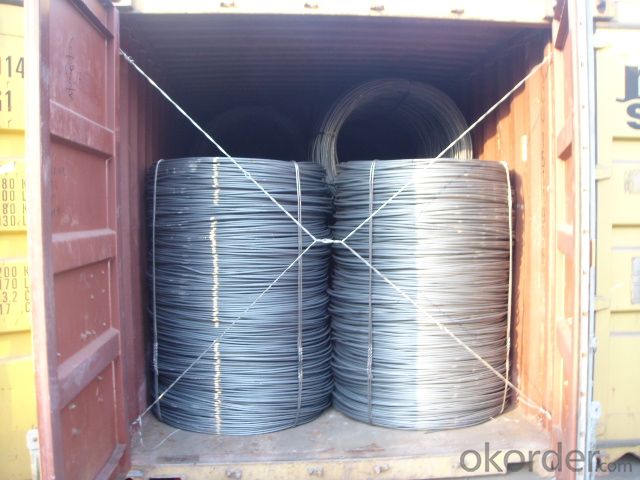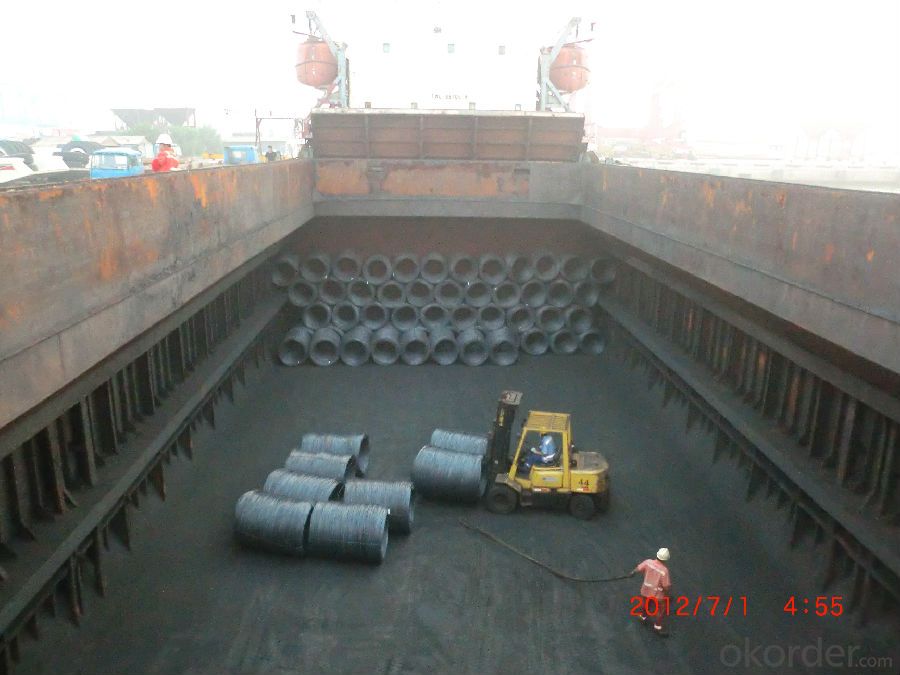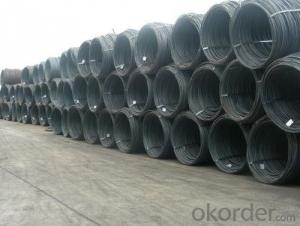Prime Hot Rolled Steel Wire Rod Low Carbon
- Loading Port:
- China main port
- Payment Terms:
- TT or LC
- Min Order Qty:
- 100 m.t.
- Supply Capability:
- 10000 m.t./month
OKorder Service Pledge
OKorder Financial Service
You Might Also Like
Item specifice
OKorder is offering Prime Hot Rolled Steel Wire Rod Low Carbon at great prices with worldwide shipping. Our supplier is a world-class manufacturer of steel, with our products utilized the world over. OKorder annually supplies products to African, South American and Asian markets. We provide quotations within 24 hours of receiving an inquiry and guarantee competitive prices.
Product Applications:
Prime Hot Rolled Steel Wire Rod Low Carbon are ideal for structural applications and are widely used in reinforcement of reinforced concrete and welded structure or reprocessed (roberts , nail, etc.) materials, especially used to produce wire drawing, welding electrode, nails, spring, electronic, precise machinery parts and so on.
Product Advantages:
OKorder's Prime Hot Rolled Steel Wire Rod Low Carbon are durable, strong, and wide variety of sizes.
Main Product Features:
· Premium quality
· Prompt delivery & seaworthy packing (30 days after receiving deposit)
· Can be recycled and reused
· Mill test certification
· Professional Service
· Competitive pricing
Product Specifications:
Steel Grade: Q195/235, SAE1006-1018B
Standard: ASTM, GB
Diameter: 5.5mm, 6.5mm, 7mm,8mm,9mm,10mm,12mm,14mm
Type: in coil, coil weight around 2MT
Alloy or Not: Alloy
Technique: Hot Rolled
Place of Origin: China Mainland
Surface: round, no twisted, light and smooth
Trademark | Rank | Chemical composition (quality score) % | ||||
C | Si | Mn | S | P | ||
≤ | ≤ | ≤ | ||||
Q195 | 0.06-0.12 | 0.30 | 0.25 | 0.050 | 0.045 | |
Q235 | A | 0.14-0.22 | 0.30 | 0.30-0.65 | 0.050 | 0.045 |
Q235 | B | 0.12-0.20 | 0.30 | 0.30-0.70 | 0.045 | 0.045 |
FAQ:
Q1: Why buy Materials & Equipment from OKorder.com?
A1: All products offered byOKorder.com are carefully selected from China's most reliable manufacturing enterprises. Through its ISO certifications, OKorder.com adheres to the highest standards and a commitment to supply chain safety and customer satisfaction.
Q2: How do we guarantee the quality of our products?
A2: We have established an advanced quality management system which conducts strict quality tests at every step, from raw materials to the final product. At the same time, we provide extensive follow-up service assurances as required.
Q3: How soon can we receive the product after purchase?
A3: Within three days of placing an order, we will arrange production. The normal sizes with the normal grade can be produced within one month. The specific shipping date is dependent upon international and government factors, the delivery to international main port about 45-60days.
Images:


- Q:What are the different wire drawing processes used for steel wire rod?
- Steel wire rod can undergo various wire drawing processes to achieve a thinner and more uniform wire with specific properties. The primary wire drawing processes for steel wire rod include: 1. Annealing: By heating the steel wire rod to a specific temperature and slowly cooling it, internal stresses are relieved. This process enhances the wire's ductility and machinability, making it easier to draw into a thinner diameter. 2. Pointing: Before drawing, the ends of the steel wire rod are typically pointed. This is done by grinding or tapering the ends to reduce their diameter, allowing for smooth passage through the drawing die. 3. Drawing: The main step in wire production is the drawing process. Here, the steel wire rod is pulled through a series of dies to decrease its diameter and increase its length. This process is usually carried out in multiple stages, with each stage employing a smaller drawing die to further reduce the wire's diameter. Drawing also enhances the wire's mechanical properties, including strength and hardness. 4. Cleaning and coating: After the wire is drawn, it is often cleaned and coated to shield it from corrosion. This involves removing residual lubricants or contaminants from the drawing process and applying a protective coating, such as zinc or copper, to enhance the wire's resistance to corrosion. 5. Heat treatment: Depending on the desired properties, the wire may undergo additional heat treatment processes after drawing. These can include quenching and tempering, which further improve the wire's strength, toughness, and flexibility. In summary, the various wire drawing processes used for steel wire rod are crucial in transforming the raw material into a final wire product with specific dimensions, mechanical properties, and surface characteristics. Each step in the process plays a vital role in ensuring the quality and performance of the end product.
- Q:How is steel wire rod used in the manufacturing of wire forms for ski lifts?
- Steel wire rod is used in the manufacturing of wire forms for ski lifts as it provides the necessary strength and durability required for supporting the weight of the ski lift cabins and passengers. The wire rod is typically shaped and formed into various components such as cables, ropes, and pulleys which are then assembled to create a secure and reliable system for transporting skiers up the slopes.
- Q:How is steel wire rod used in the production of wire mesh for mining and quarrying applications?
- Steel wire rod is a crucial component in the production of wire mesh for mining and quarrying applications. It serves as the raw material that is processed and transformed into a variety of wire mesh products used in these industries. The steel wire rod is drawn, stretched, and twisted to create the desired thickness and strength required for the wire mesh. This mesh is then used in various mining and quarrying applications such as reinforcing tunnels, screening materials, and providing structural support. Overall, steel wire rod plays a vital role in ensuring the durability and effectiveness of wire mesh in mining and quarrying operations.
- Q:What are the common sizes of steel wire rods?
- The common sizes of steel wire rods vary depending on their intended use and application. However, some commonly available sizes range from 5.5mm to 32mm in diameter.
- Q:How is steel wire rod inspected for quality control?
- Steel wire rod is inspected for quality control through various methods. Firstly, visual inspection is conducted to check for surface defects such as cracks, scratches, or deformities. This is followed by dimensional checks to ensure the wire rod meets the specified diameter and length requirements. Additionally, mechanical tests like tensile strength and elongation are performed to assess the wire rod's strength and flexibility. Chemical analysis is also conducted to determine the composition of the steel, ensuring it meets the required standards. All these inspections help ensure that the steel wire rod meets the desired quality standards before being used in various applications.
- Q:What are the common production processes for actinium-coated steel wire rod?
- The common production processes for actinium-coated steel wire rod include wire drawing, cleaning and surface preparation, actinium coating, drying, and final quality inspection.
- Q:How is steel wire rod used in the manufacturing of wire for electrical cables?
- Steel wire rod is used in the manufacturing of wire for electrical cables as it serves as the base material for producing the wire. The steel wire rod is first drawn through a series of dies to reduce its diameter, resulting in a thinner wire. This wire is then coated with insulation material, such as PVC or nylon, to provide electrical insulation and protection. The steel wire rod's strength and durability make it an ideal choice for providing structural support to the electrical cables, ensuring their reliability and longevity.
- Q:What are the different types of steel wire rod rolling mills?
- There are several types of steel wire rod rolling mills, including continuous mills, semi-continuous mills, and reversing mills. Continuous mills are designed for high-speed production and feature a constant flow of material through the mill. Semi-continuous mills allow for a slower production rate and are ideal for smaller-scale operations. Reversing mills have the ability to roll the material in both directions, providing flexibility for different product specifications.
- Q:How is steel wire rod packaged for transportation?
- Steel wire rod is typically packaged for transportation by being bundled together and secured with steel strapping or wire ties. The bundles are then stacked on wooden pallets or loaded into steel crates for added protection. Additionally, some manufacturers may opt for further packaging using shrink wrap or plastic covers to safeguard the wire rod from moisture, dust, and other potential damages during transit.
- Q:What are the disadvantages of using steel wire rods in construction?
- There are a few disadvantages of using steel wire rods in construction: 1. Corrosion: Steel wire rods are susceptible to corrosion, especially in humid and coastal areas. When exposed to moisture and oxygen, steel can rust over time, leading to structural weakness and deterioration. This can compromise the integrity of the construction project and increase maintenance costs. 2. Weight: Steel wire rods are heavy, which can make transportation and installation more challenging. The added weight can also put additional stress on the foundation and supporting structures, potentially leading to structural issues over time. 3. Limited flexibility: Steel wire rods have limited flexibility compared to other construction materials like concrete or timber. This can make it difficult to accommodate complex architectural designs or unique construction requirements. 4. Cost: Steel wire rods can be expensive, especially if high-quality materials are required. Additionally, the cost of transportation, installation, and maintenance can add up, making it a less cost-effective option for some construction projects. 5. Thermal conductivity: Steel has a high thermal conductivity, meaning it can transfer heat quickly. This can lead to increased energy consumption and higher heating or cooling costs in buildings constructed with steel wire rods. 6. Environmental impact: Steel production is resource-intensive and can have a significant environmental impact. The extraction and manufacturing processes emit greenhouse gases and contribute to pollution. Additionally, the disposal of steel wire rods at the end of their lifespan can also pose challenges from an environmental standpoint. Overall, while steel wire rods have numerous advantages in construction, it is essential to consider these disadvantages and evaluate alternative materials based on the specific project requirements, environmental concerns, and budget constraints.
1. Manufacturer Overview |
|
|---|---|
| Location | |
| Year Established | |
| Annual Output Value | |
| Main Markets | |
| Company Certifications | |
2. Manufacturer Certificates |
|
|---|---|
| a) Certification Name | |
| Range | |
| Reference | |
| Validity Period | |
3. Manufacturer Capability |
|
|---|---|
| a)Trade Capacity | |
| Nearest Port | |
| Export Percentage | |
| No.of Employees in Trade Department | |
| Language Spoken: | |
| b)Factory Information | |
| Factory Size: | |
| No. of Production Lines | |
| Contract Manufacturing | |
| Product Price Range | |
Send your message to us
Prime Hot Rolled Steel Wire Rod Low Carbon
- Loading Port:
- China main port
- Payment Terms:
- TT or LC
- Min Order Qty:
- 100 m.t.
- Supply Capability:
- 10000 m.t./month
OKorder Service Pledge
OKorder Financial Service
Similar products
New products
Hot products
Related keywords




























